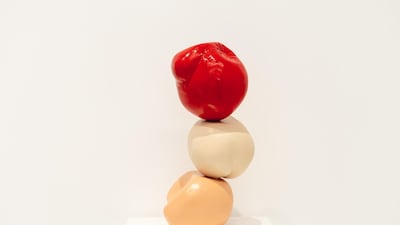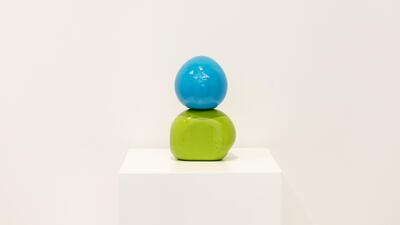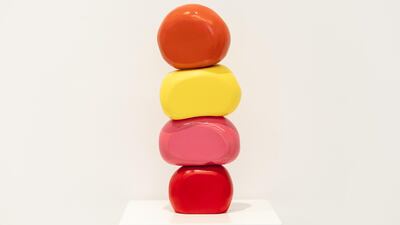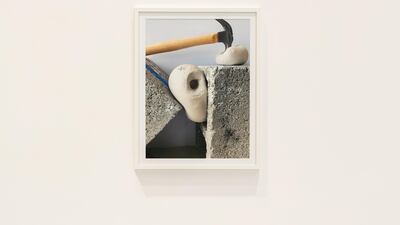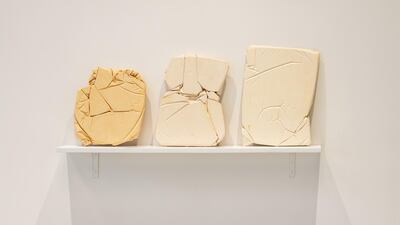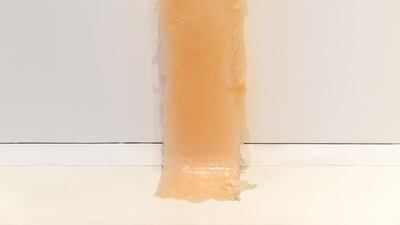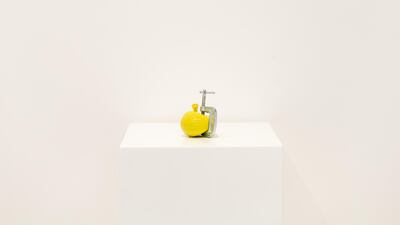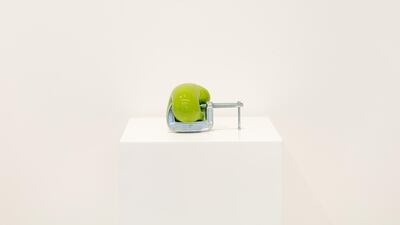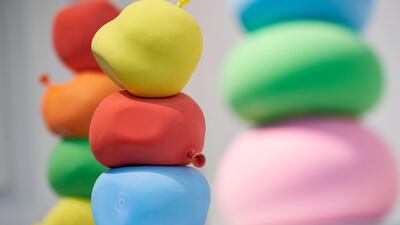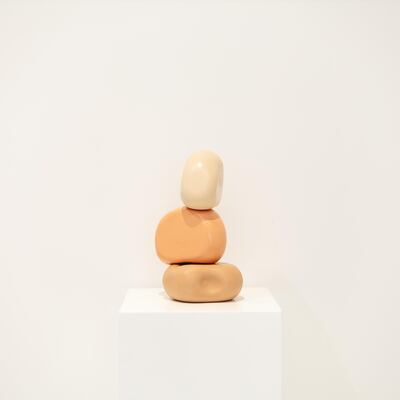Sara Ahli’s sculptures can be playful. Some are made with stacks of vibrant, rounded clumps that resemble toys or candies. Others can make one feel a little prickly, such as the work with a blood-red mass sitting on top of beige-coloured globs – a misshapen heart sitting on sacks of flesh.
But a bodily reaction seems to be the point. The artist's debut solo exhibition Placeless Place, which opened on Wednesday at Foundry by Emaar, is comprised of sculptural works that examine material and the body.
On view until Wednesday, March 3, the show is the third presentation of art-collecting platform 101, which was established in 2020 by curator Munira Al Sayegh and writer Gaith Abdulla. The aim of 101 is to grow the network of young collectors in the region without necessarily relying on traditional gallery models.
Ahli's works were created specifically for the exhibition, produced in her studio over the past two weeks. Her Balloon Stacks were made by filling balloons with plaster and then compressing them in a vacuum bag or with panels.
After seeing the resulting shapes, she was reminded of body parts and skin texture, which led her to paint some of the works in flesh and blood colours.
“With the flesh-tone colours you start to see things like the navel or a crevice in the body,” she says.
Casting anatomical elements through sculpture continues throughout the show, as seen in Collection of Bones, A Spine, its arched fragments of white plaster resembling fossils or bones in an archaeological display.
The hanging work Skin has a grotesque quality. Made to mimic human skin, the pigmented silicon rubber piece was created by pouring the material repeatedly to form a sheet. "I wanted to show that skin has layers, textures, lumps. I want people to feel something in their body when they see it," Ahli says.
Other times, Ahli is playing with presenting her sculptures in new ways. Her Clenched Figures are the usual balloon and plaster, but she added a metal clamp for a more "industrial" appearance, she says, which she contrasts with glossy resin for a "finished product" look.
Born in 1993, the Emirati artist studied at the California College of the Arts on a scholarship. Though her background is in fashion design, she began experimenting with sculpture after being introduced to the fine arts scene in the UAE in 2018. Last year, she was part of the Salama bint Hamdan Emerging Artists Fellowship, during which she first produced her balloon sculptures.
Her interest in sculpture has roots in her love for fashion design, she says. “I felt this need to build, to construct 3D pieces. It’s like fashion design, where you take a sketch that is two-dimensional to something three-dimensional,” she explains.
With her process-based practice, Ahli also documents the phases that her sculptures go through. She stages photographs and videos of her materials, exaggerating their shapes and textures with close-ups or editing. They serve as studies for the artist, who says the images provide ideas on how the material can be manipulated.
“Documentation allows me to understand what’s happening with the material. I photograph the process and this gives me ideas to explore later on.”
Ultimately, it is her time in the studio, working with the material directly, that renders the best results. “I sketch out mock-ups, but I have to touch and feel the material. It speaks to me and tells me what it wants to do,” she says. “I use a lot of my hands to think.”
As with previous 101 exhibitions, the artworks on display are on sale, with prices ranging between Dh440 to more than Dh4,000. The works are also available on 101’s website.
Placeless Place will be accompanied by a public programme that responds to Ahli's works and was developed by 101 and three UAE art collectives, namely Sa Tahanan Co, Banat Collective and Postscript Magazine.
The collective-led programme includes a poetry performance tour on Saturday, by Sa Tahanan Co, where verses related to the artworks will be read in the gallery space. On Monday, Banat Collective will be hosting an online critique session that will consider Ahli's concepts, as well as ideas of the body and identity. The final event in the programme is an arts writing workshop by Postscript Magazine, which will explore forms such as flash fiction, automatic writing and poetry.
Placeless Place is on view until Wednesday, March 3 at Foundry by Emaar, Downtown Dubai. To register for the public programme, visit 101.art
